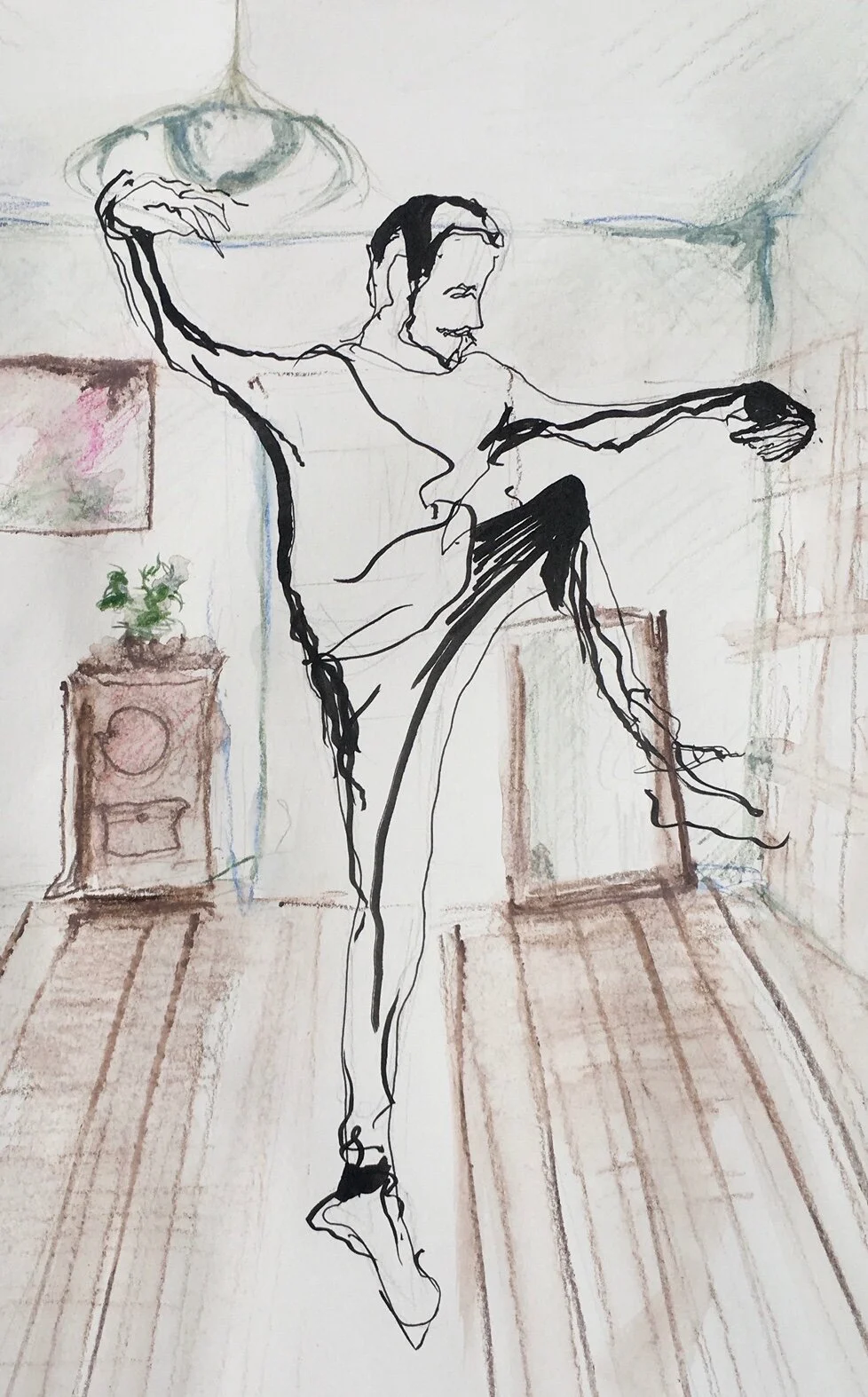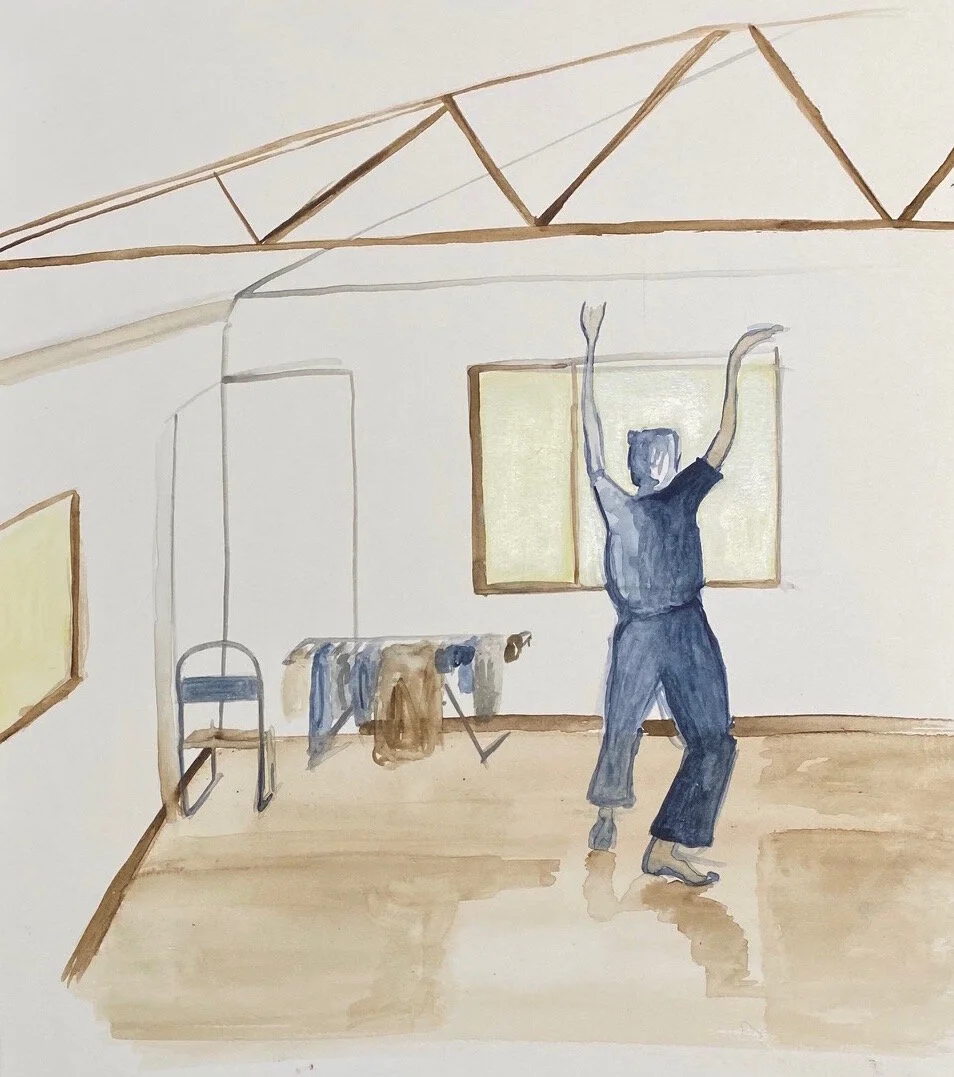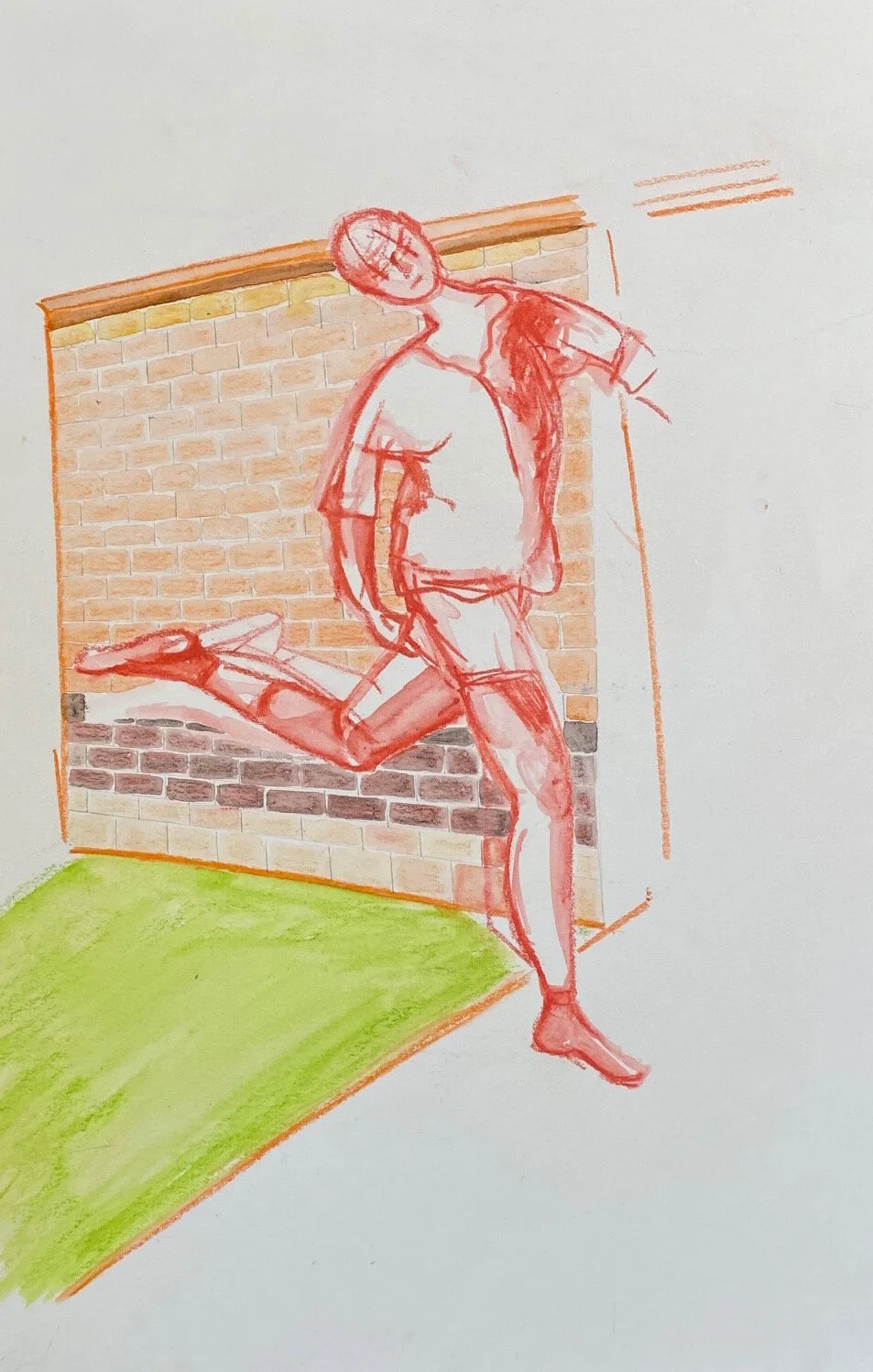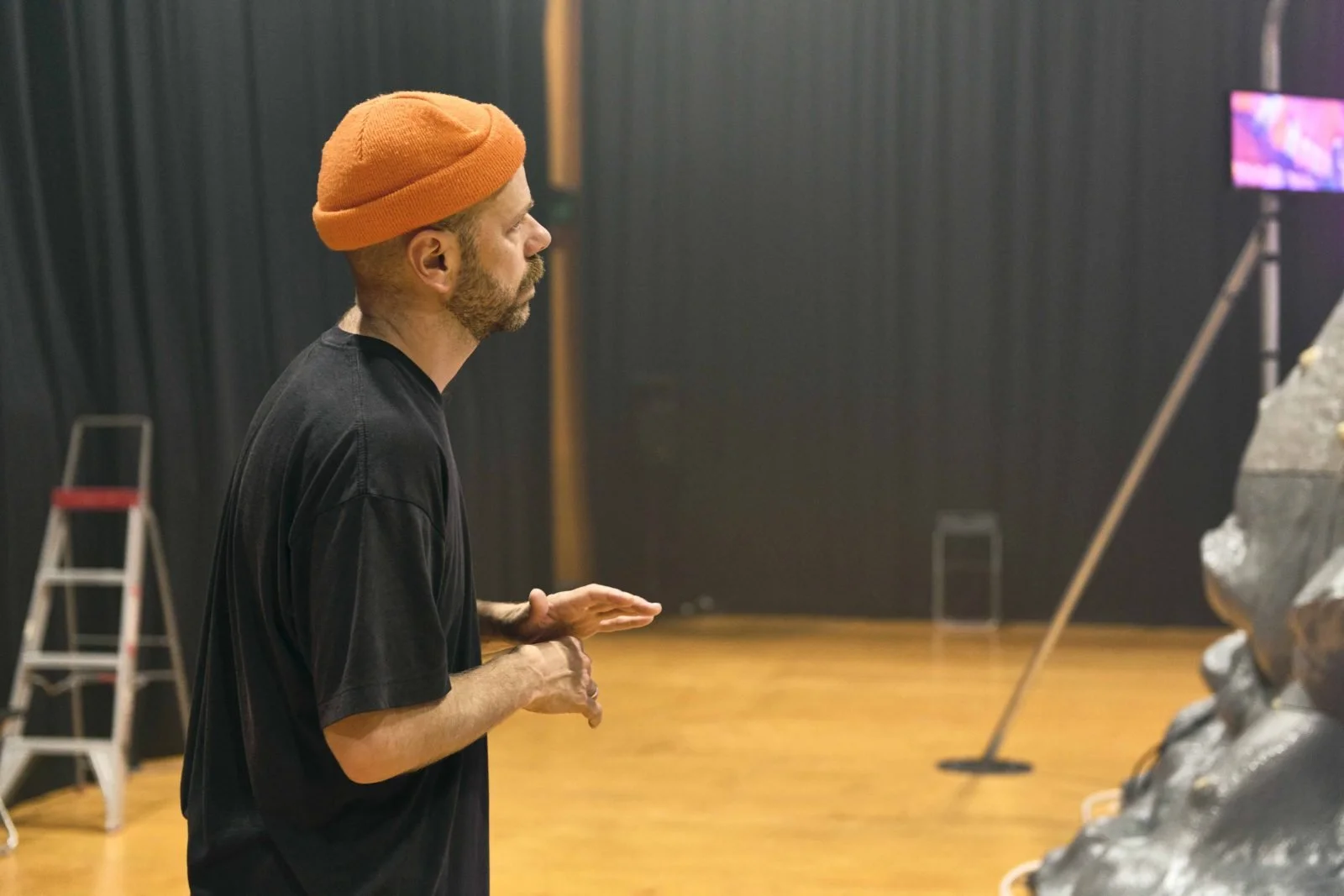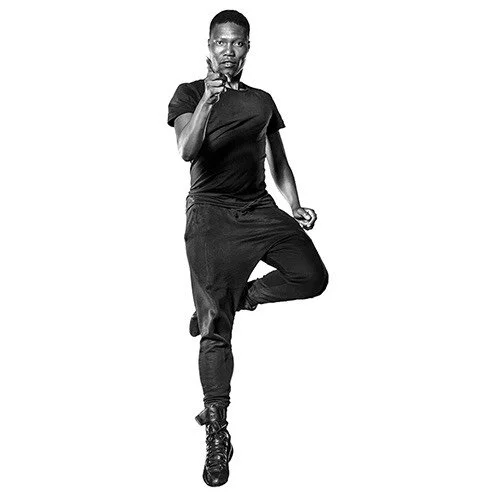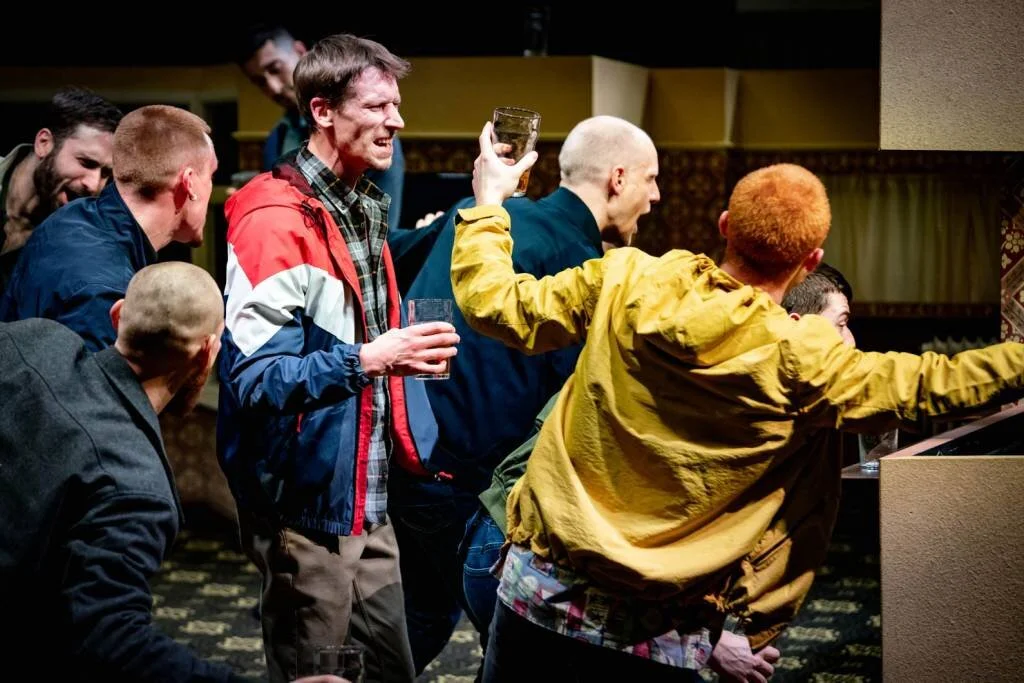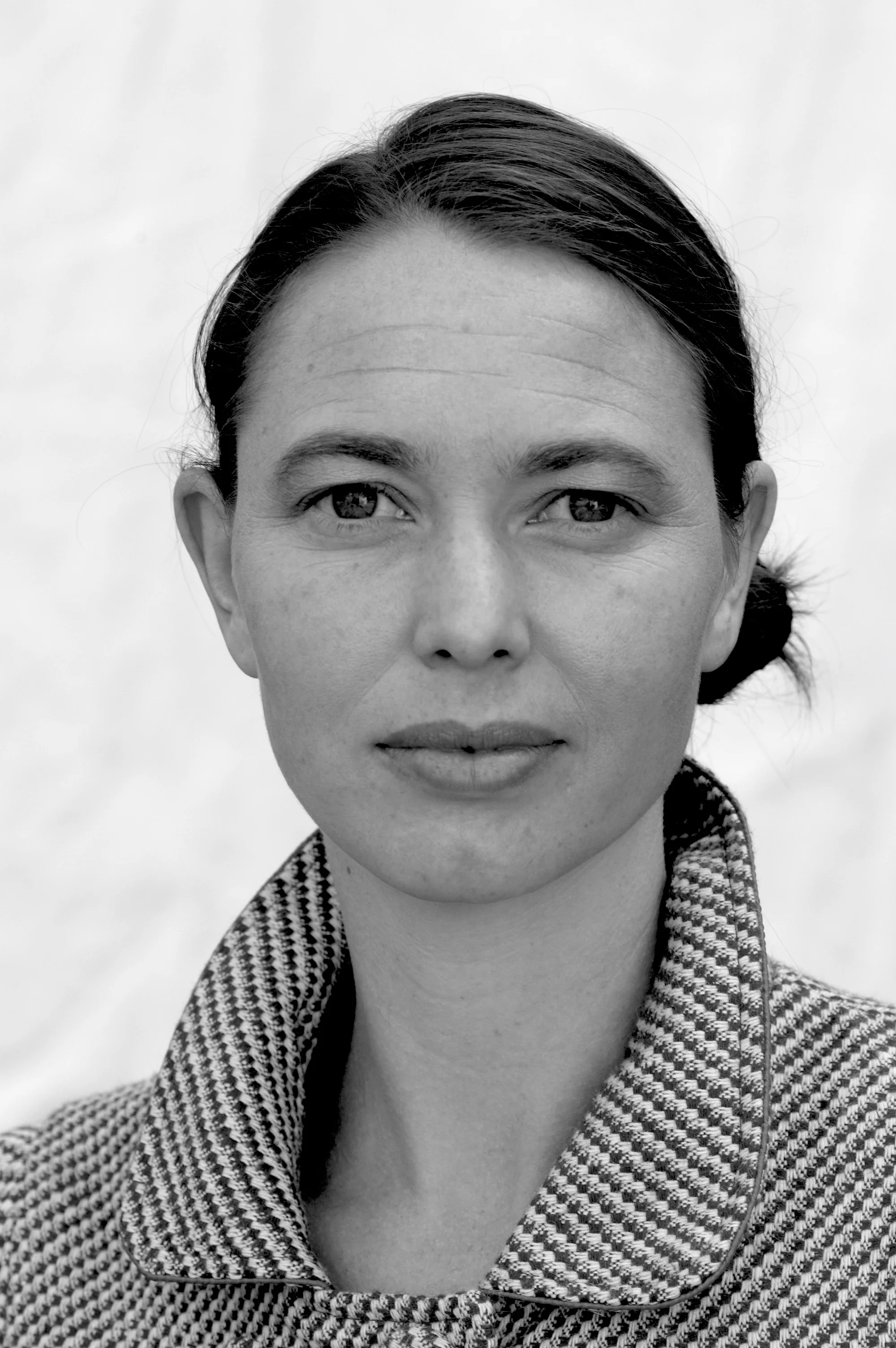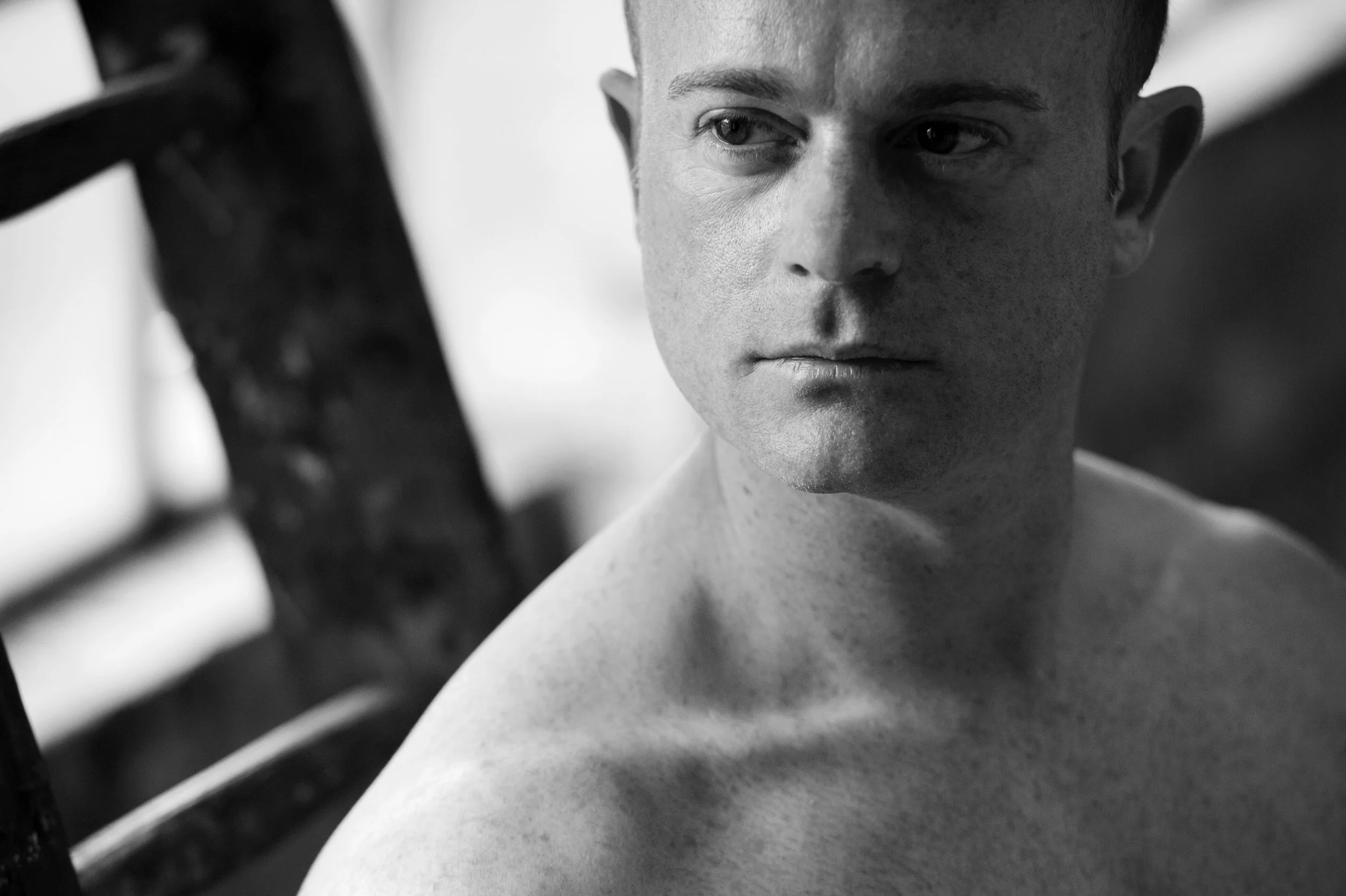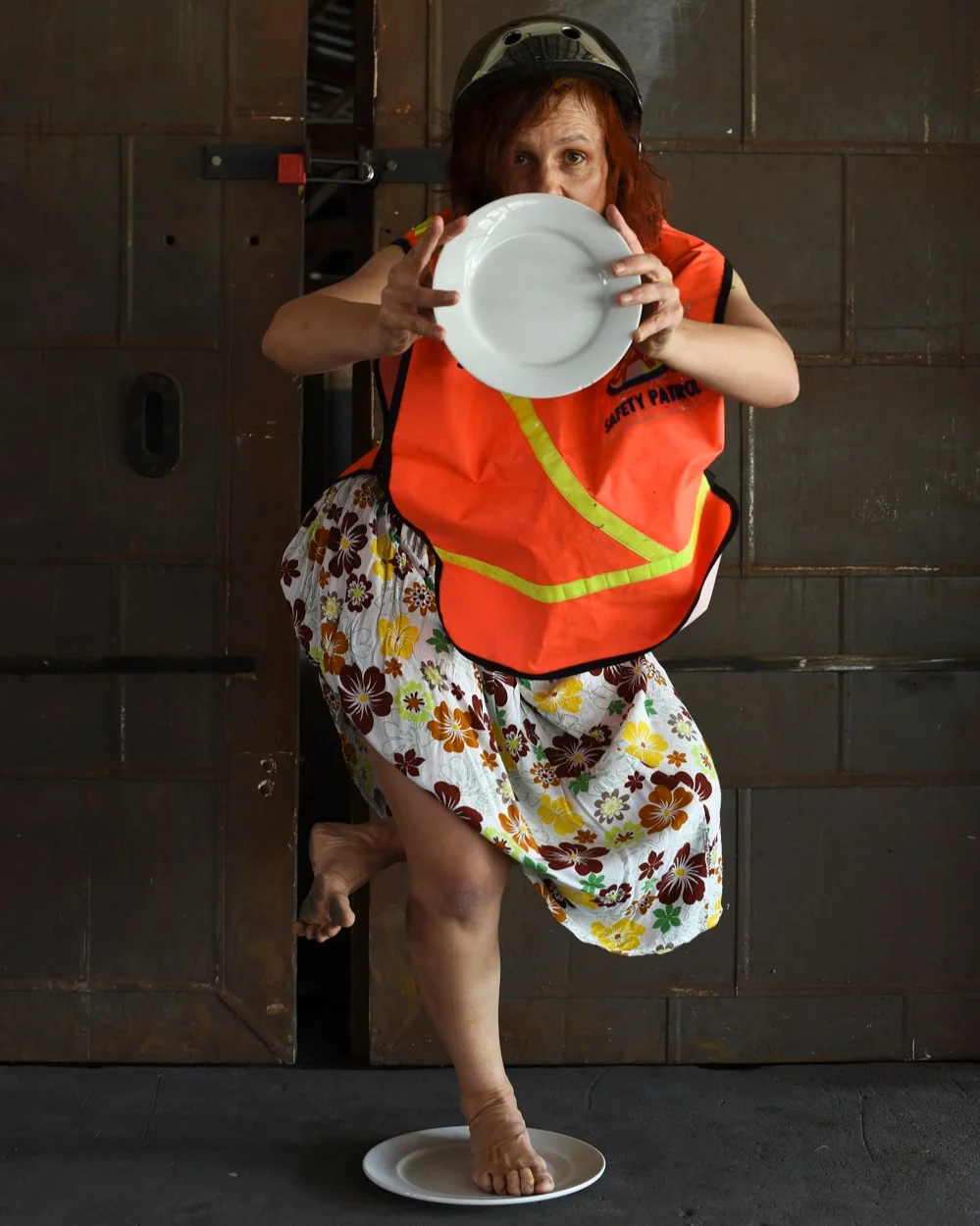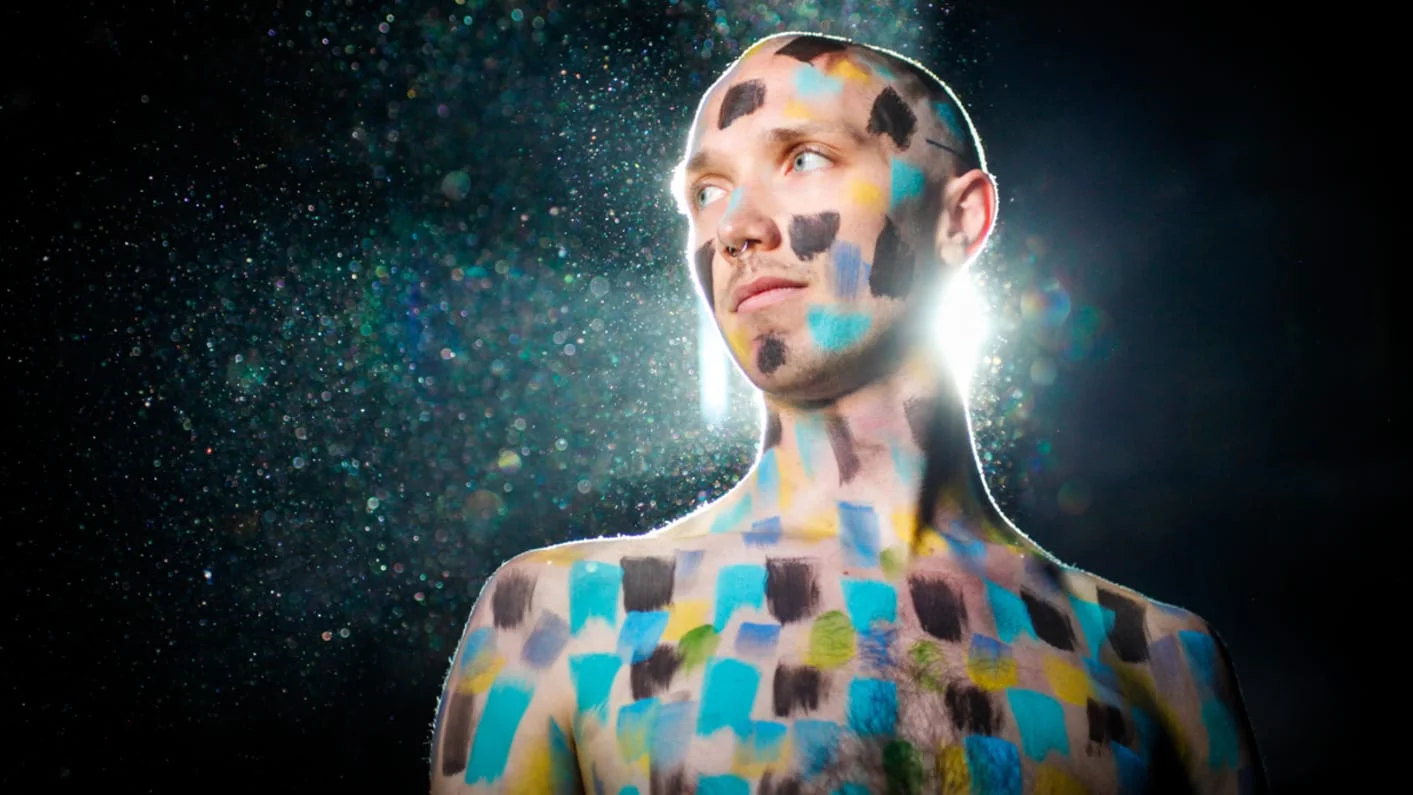– ‘Glenn Henn’ is the pen-name of Caroline Meaden and William McBride. Illustrations by Alice Dixon and Caroline Meaden.
ADDENDUM: This conversation took place in December 2019, probably just before COVID-19 entered the human population in Wuhan, but like many aspects of our society, the current health crisis has highlighted and exacerbated the existing dysfunctions and inequalities in the arts.
Meanwhile, with the recent round of Australia Council for the Arts four-year organisational funding leaving only eight dance organisations funded Australia-wide, it has been made starkly clear that already tenuous professional pathways for working dance artists will only find dead ends within the current cultural funding structures.
Jobless, at home, dancing on our own, with the performing arts sector ground to a halt, now is the time to conceive of better models, of something that might actually work. ‘MDC’ is one proposal.
I HAD A COFFEE at 3pm yesterday, which I never do – and it was like 11 or 11.30pm, and I was just lying there. And I was thinking about, um, I was thinking about the Major Performing Arts companies and that idea of, like, applying for money as, like, ‘the Melbourne Dance Cohort’ and I was like, looking up Sydney Dance Company’s Financial Report to find out what sort of figure we would apply for and then I was on the calculator, like, ‘This many million!’
How many million?
Well Sydney Dance Company’s total annual income, which is not just from government, is $12 million-and-something. That was in 2018.
There were a bunch of different breakdowns on there, how much they gathered from sponsorships and how much money they’d spent on sponsorship events and activities and philanthropy stuff. Which was, you know-
2 million?
(Laugh.)
It was more than $200,000, anyway.
Yeah. The, like, nice cheese and stuff.
(Laugh.)
Yeah, you’d have to go to one of Creative Partnerships’, you know, workshops in order to find out how you go about running one of those events, I suppose.
You’d also try and get free booze and stuff like that. Sponsored booze.
Yeah. So how would you spread 12 million in your company?
Some of that was in kind, I think.
Oh yeah.
Yeah. For space and whatnot.
Ok. Let’s say 10 million.
10 million.
How do you spend 10 million?
That’s a big question. (Laugh.) Well some of it would have to be on, you know, events in order to get rich people to give us more money.
Yeah.
And then the rest of it would have to be on-
The large number of people who would be involved.
You mean the cohort of dancers and choreographers that would be involved?
Yeah.
Yeah, well. It would do some crazy things to the statistics of, like, touring and attendance and stuff.
But, you know, you wouldn’t be able to pay that many people to make work, really.
It sorta feels like grabbing money and becoming a, like, grants body but within the-
Yeah. Because some of it would go on administration. I don’t even know how much.
You’d be paying artists to live.
Like the lottery.
The lottery, yeah. Like, you get whoever the fuck wants to sign up for it and then just apply yearly, like, you have-
20-50 people or something. Or maybe more? I’m not sure…
Yeah, I wonder how many?
It would have to be fairly broad…to be quite democratic.
Well you would only be applying for, like, four million from the Federal Government. It wouldn’t be 10. But then you would get some from the Victorian Government as well, so maybe it would be up to six?
It’s $100,000 each for, like, 100 people.
Yeah, right.
So you could have, like, $40,000 each.
What, that’s with 10 million?
Yeah.
Yeah, which we wouldn’t be able to get straight up. We’d only be able to get say, six, and then we’d have to fundraise for, like, another four. I don’t know?
So we get 6 million…and then divide by 100, so that’s $60,000.
Which is enough to live and, like, pay for some other people to do stuff.
Yeah. And it’s not your only source of income.
(Laughing.)
Yeah I don’t know how you would administer that. And we wouldn’t get it anyway-
No, but you’ve gotta pretend that you would.
Yeah. So. Anyway I was just looking up that.
Do you think it’s like, years of service? Like, for eligibility?
To the field?
Yeah.
Yeah, I guess.
After five years of service? You could be like, ‘Have you done your fifth show?’
(Laugh.) Yeah, maybe.
In the US Democratic debates they have, like, certain polls, that, ah – they have different thresholds for who gets to be on the debate stage and you have to be above a certain percentage in a national poll, or above a higher percentage in an early state poll. And then you need, like, *this* amount of money, but from *this* many donors, so there’s a few different criteria that are kind of agreed-upon markers. Everyone could argue that they are, like, unfair, or fair, or whatever.
Yeah, and everyone has to agree.
You could have a few different ways of reaching eligibility.
Sure. Cos there’s so many different ways of being ‘in service to dance’.
Yeah. Cos you wouldn’t want to just make everyone do more applications all the time.
No. I think there’s a degree of lottery to it, or something.
Yeah, cos you wouldn’t want it to just all be about, like, the idea for a show.
Yeah.
Cos that’s dumb.
Yeah. And you get a base salary.
Yeah. You get a base salary. Creative Victoria, for their Independent Producers Initiative, which is still a bit confusing to me…they’ve got some kind of program you can apply to if you’re a producer where you get a wage of, like, $45,000.
Oh yeah. Do you think it could be that much? I keep thinking we should be quite conservative with it. It could be $30,000.
Yeah I don’t think – I was just thinking, I don’t know of an arts program where you can just get $45,000 by being – other than winning a fellowship – by being an artist, like everything’s gotta be tied to a project rather than a history of working.
Yeah, well I think even with the OzCo fellowship, you apply with a proposal.
Yeah, right.
Whereas the, like, Myer one, you don’t even know you get it or something. Someone nominates you and-
And there you are.
Yeah.
(Sigh.)
Cos it’s sort of, like, robbing – it’s saying, ‘We don’t like your way of administering the funds, so just give us your funds and we’ll administer them.’
J sometimes says he thinks societies would be better if they just started again every sort of 30 years, like, with their legal framework, rather than being-
Hmm. It takes about 30 years to get it going.
But I was thinking you could have, like, a few years of one model and then, ‘We’re canvassing for a new model.’
“...the actual art form of dance depends on a lot of people regularly being in the same space working together. Like, literally, physically, a lot.”
Yeah, well I think that’s the interesting thing about having to apply for stuff all the time. Maybe more people should be applying for, or at least re-considering, their position every now and then, re-considering the framework…. You know, it’s counter-productive to be doing it constantly and never getting any money, but there’s gotta be, like, a happy medium where there’s some kind of re-set, cos it makes you think about what you’re doing and what your relevance is and-
Yeah. I think a fairly thoroughly articulated model would be an interesting Delving Into Dance thing.
Mmm.
Like a re-designed structure would be quite an interesting provocation to, like, publish.
Yeah.
Speculative, but-
But nevertheless. It’s an exercise in- We can ask people at our meeting.
Yeah. Like, we could design the MPA company just, like, on paper, and publish it.
Mmm.
And gather touring stats and-
And you could have sort of shoddy- like, in order to not become overwhelmed by admin tasks that are insurmountable you could take 20 people and ask them what their output is and use that as a representative sample that we extrapolate out to-
Yeah. Cos it is such a kind of strange hurdle to, like, conceive of yourself, or your practice, or your peers, in a context like that. Which is partly what the issue is with applying for multi-year funding. It’s like, what is that feeling, assuming there’s a need for this layer of bureaucracy between you and the funding decisions?
Yeah, and that you go into these situations and there’s this intimidation – not that you’re intimidated but that there’s like a bureaucratic class. A bureaucratic class that you’re not a part of, and that, on its own is a block. Feeling like you don’t have the language, or the frameworks, and that if you put something forward that it must be laughable, or-
Or so naive, or-
Ill-informed or something.
Yeah.
I love D’s idea of ‘the Practising Artists Sector’.
Yeah. (Laugh.) As opposed to ‘the Arts Sector’.
I think a big thing should be stripping the business stuff, like the entrepreneur sole trader stuff, out of the language.
I think the weirdest part of operating in this stupid ‘independent’ thing is that you’re competing with people you know for something that you’ve got a 10% chance of actually getting. Yet the actual art form of dance depends on a lot of people regularly being in the same space working together. Like, literally, physically, a lot. I think LGI having that new space has been really quite amazing for the industry in just one year.
Yeah, and they seem to know that, like how they make the classes cheap and have the coffee and the bickies and stuff.
I think there’s something weirdly atomising about having this funding structure imposed on something that doesn’t operate like that.
There’s also no rule of nature that says a valuable company must make a couple of spectacular large works per year, which tour lots of places, and play to very rich auditoriums. Like, that’s not what’s demanded by the culture – that’s a hangover from a bunch of other things.
Well, yeah, I guess we’re getting to an era where touring is more questionable as an operational given.
Or the work as a, like, a great product, yeah there’s something weirdly neo-liberal about these works with one or two people..
Lean.
Lean, clean concept.
Four-person touring party.
Yeah, so economical, and yet, carbon-wise, yeah, I don’t know, I mean you don’t want to be condemning things but I just...yeah, what’s ‘the company’ now?
Yeah. Because if it stops – that product making obsession, what happens to that impulse? Does it go into more of a collective good?
Yeah, and what is ‘touring’? Like, it’s dissemination. It’s not only packaging a product, it’s also dissemination and exchange, that can happen in a more viral kind of...I’m just thinking of the way in which stuff ripples through a scene, filters through....
Yeah. There’s also this thing of ‘the imagined format’. There’s, like, a history of utopian kind of writing that designs a bill of rights or, like, a legal framework, or some speculative thing. I think it’s kind of cool.
Totally. I also think a lot of people probably feel like they don’t have the permission or the expertise to do it. You know we had to do it for Chunky Move when we did that interview, and I think for me, it’s a block, that thing of ‘Do I have the right to decide?’ I think that’s a huge thing that holds a lot of independent dance people back, especially you know, young people and women.
Yeah. Why women? Like, I know, but just say it out loud?
Well I just mean the fact that there’s so many young women operating in this sphere just exacerbates all of those issues around, you know, voice and authority, and permission to decide what you want.
Shall we quickly design the-?
Quickly design the new MPA?
(Laugh.)
Yeah
So, how do you spend your 10 mil?
So we get 6 million from Federal-
No, 4 million’s our Federal.
Oh ok, and we get two million from-
Sponsors?
From Victoria.
“There’s also no rule of nature that says a valuable company must make a couple of spectacular large works per year, which tour lots of places, and play to very rich auditoriums.”
Oh, ok. Yeah.
Yeah…let’s get 4 million from Australia Council and 2 million from Creative Victoria. (Laugh.) I don’t know what I’m talking about. And then, umm, 4 mil from sponsors and shit.
So 10 million.
10…what does that sound like?
Yeah 10 million. Sounds like 10 million bucks!
(Laugh.)
Ah, so, well, first of all, if we were applying for the money we would need to have the people-
The company membership-
Yeah, from whom to draw the stats.
Yes. And so, beforehand you would have a sort of recruitment.
So you would need to pay for an administrative procedure for all of this.
Who does that?
So we’ve got us, and someone else. I don’t know who? Maybe there’s, like, six administrative positions, cos you would need some underlings as well.
So this is before we get it?
We have to have some stuff in order to get it, right? I mean we probably really have to have at least some private sponsorship anyway before we would get it.
I think for the purpose of this exercise we just, like, have whatever we think we need.
We just have it, ok.
We could have a board.
Who would be on the board?
I think it’s probably fairly expansive, like...20 or 50 people?
That’s a big board. Well I guess there’s a lot of people.
There’s a lot of stakeholders, and they’d have to have meetings-
You couldn’t have meetings with 50 people in attendance. 20?
You could design, like, a tenure to be a bit more rotating. In the Senate they have six-year terms, and every three years there’s a vote on half of the Senate, so that people have kind of double terms, so there’s always one half of the Senate that is continuous, in order to retain institutional knowledge, and to put the brakes on radical – like a Trump kind of situation, or a radical new government where you’re totally blasting away everything. You could have board structures that are, like, a structured approach to a transient membership.
Mmm.
So the model is...it isn’t looking to be, like, its own fiefdom, or to have its own home-
It needs to just be a re-categorisation of what’s currently happening-
What’s existing, yeah.
Yeah. These are all the artists.
But then how do we...how do we deal with charges of exclusivity and allegiance, and who’s in and who’s not? Maybe there’s like a points system rather than a money system.
What do you mean?
Like years’ service.
Yeah...well I think people can self-nominate but also, like, I think there’s gotta be some, umm-
Cos if you cap it at 100 people there’ll be 150 people, or however many people, going, ‘What the fuck?’
Yeah, and you can’t just do a regular application process.
No.
But if you just say, it’s not capped but the more people in it, the less money everyone gets, but they get a proportionate amount based on years of service.
Yeah. But there would be so many people, wouldn’t there? I mean, how many people realistically, would there be?
The thing is that with the grads coming out, it’s like 100 new people every year.
But it’s- Are we just Melbourne based?
Yeah.
So maybe 50 new people each year, but, also, we have a certain VCA-centric...view.
And there’s people coming here from interstate and elsewhere-
Yeah.
Umm, so we gotta find some measures….
Well I think, like, maybe a helpful thing to go back to is, like, this thing of, if you’re putting on a show, you’re getting an audience, you’re touring, you’re making box office income, like, these types of metrics that are-
Yeah, conventional.
And so that’s the first thing, to emulate an MPA company according to that logic, but then there’s other things, like, people who are dancers, people who are teachers.
Yep.
You know, but not necessarily show makers-
But who have lots of things to offer-
Yeah. I think it’s ‘the practising artists sector’-
Uh huh. ‘Practising dance artists sector.’
Is it, like, means tested? I mean is it, like-
Yeah, maybe. Yeah you could do that, it depends if...maybe the membership thing we can set aside for a while-
Yeah.
And think about what the money would go towards. Like, some money goes towards just, like, basic income for a verified practising artist dance sector person, and then some of it goes to, like, funding shows.
I think we provide a certain amount that’s, like-
This is what you get-
This is just for you as an artist to live.
Ok.
And then we have a separate part that’s, like, supplementary-
Yeah, for projects, and it would be, maybe it’s like one of the income streams of a development, along with creative project grants.
Yeah, right, ok.
Alright, so what do we say, like $50,000? Is that too low?
I think it…I always feel more conservative with this stuff.
$30,000?
Yeah I think it’s more like $30,000 because if it’s, umm, $40,000 or $50,000 then people will be, like, I don’t have to pay you for what you’re doing.
Yeah. What do you have to do to remain eligible? This is the most tricky question.
Yeah, I mean it’s how do you quantify value to the sector? You can’t just say making shows is the thing.
It’s almost like, you know how you pay your union membership fee? It’s almost like a version of that, but not through paying a fee, through demonstrating your active service.
So maybe it’s really case-by-case?
Yeah, maybe you submit to the board a report that’s, like, up to you what you say?
Of your activities, yeah. Has to be sort of verified by a couple of people, or something.
And it’s not, like, a grant application but it’s an annual submission of your service to the industry, to the form.
“...how do you quantify value to the sector? You can’t just say making shows is the thing.”
I was reading Sydney Dance Company’s report of their activities for the year and it was pretty, like, basic. We did this. We had these people attend. Here’s a photo.
Yeah, that’s the other thing about – I only read it once, but when I was reading the, like, policy document for the new MPA framework, they have this contractual language – ‘This must be met’, or ‘This has exceeded the…’ – but then if you’re, like, What is that actually? Like, ‘engagement with the blah blah sector blah blah’, but what that actually is, is quite open ended.
Totally.
And you can spin it in some way that it seems like ‘Oh, you’ve satisfied that.’
And for anyone that, like, can’t be arsed reading that you would just be, like, ‘Sure’.
So the money is like basic income?
Yeah.
And then grants, and then, like infrastructure.
Infrastructure. Is that administrative staff? Or, is that something else?
Yeah I suppose so.
Umm, so then the grants, so that would be a sort of set amount, based on the dollar amount and the number of people.
So it’s like ‘Oh in 2021 what was the, umm, MPA Dance Project Contribution?’ and it’s, like, ‘It was $7800 for everyone.’
Oh yeah, sure.
You know, and so that $7800 goes into an artist budget that includes other things.
It seems low, but-
It seems low, but it means that Creative Vic can’t shut you out because you’ve-
Already got that, yeah, yeah.
They’re like, ‘Oh good, that’s a good start.’
Well this is like what Besen already does.
What Besen does, yeah.
So it would be something, like, it does mean things to people to get that.
It gets stuff going, yeah.
Otherwise it’s like, ‘Next stage you have to…’
Yeah, it’s an application.
A grant process-
Yeah, based on the ideas and shit.
So basically what it is is looting public funding and spreading it out in a different way – not about ideas, not about grant writing-
And not about, like, ‘That’s not enough to leverage-’ blah blah
And it’s pitched at these amounts. $30,000 to live on, $7800 for a project. That’s, like, ransacking the thing in order to provide dignity.
Yeah and each person just provides a report, to validate what they’ve done.
Yeah. “This project failed to succeed. But I learnt something.”
(Laugh.)
Also I think there’s something about it being dance, and not just, like, general. It’s unusual.
Yeah, because writing up your dance idea is, like, especially impossible, and so you do need a, like, structural re-think, for dance more than for anything else.
Yeah maybe, but it definitely feels like the practice of dance needs to be something that you can do regularly, in the way that M is like ‘Oh, we don’t go to morning class in the theatre!’
Like you need to be able to do it, in order to do it.
Yeah.
Also I reckon in designing this, it could be helpful for this exercise to link things to MPA-based orthodoxies, like-
Somehow, like, both work with and antagonise it-
Like, as a frame of reference.
Hmm.
So how does this admin ‘infrastructure funding’ work?
It’s like ‘jobs artists can do’, so, like, ‘There’s some shifts going at the co-op. Who wants ‘em?’
Yeah, ok. It would be an interesting way to administrate the idea of, like, putting up independent artists in schools or artists in residence at institutions.
There could also be, like, an income stream boosting. Like, we have a philanthropic officer whose job it is to get money from rich people. You could also have someone here who’s looking out for those sorts of artists-in-schools sorts of opportunities and stuff.
Yeah.
The main thing is to make this, like, ‘Don’t touch *this*’. And so if you get a gig to go to a school you don’t do it for free, you get a fee.
Yeah, cos any artist fee you get, currently, feels like it should be in addition to a proper wage rather than a supplement for it cos they’re so small, so it kind of makes sense.
Yeah. Cos your proper wage is, like, the other jobs you do, at the moment.
At the moment, yeah.
Umm, so could it be a $10,000 grant and $30,000 income, and then you see where you get to in terms of the number?
“Oh, we don’t go to morning class in the theatre!”
See where you get to, meaning…?
Like $40,000 per person.
Yeah, oh, you mean, like, putting that all in together? Yeah, yeah.
Plus, you could mandate what you spend on admin as a percentage of total costs.
Maybe it’s 10% on admin?
Try that.
1 million. So then you could just be, like, no more than 10% is spent on admin.
Yeah 10% sounds alright…so 10 million minus 1 million is what you’ve got to play with here.
Yeah. 9 million.
So then that divided by $40,000 is, like, how many people you can fund?
(Calculates number of possible funded company members: $9,000,000.00 / $40,000.00 per person = 225 people.)
That’s pretty good.
That is a lot, yep, yep, cool.
The reason that this is possible as opposed to Sydney Dance, is that we’re not including a venue on The Rocks, major tech, we’re not including all of that stuff.
Yeah, you just have this thing behind you.
Yeah and everything else will be ok.
Yeah, just take out one of the orchestras and everyone will be ok.
(Laugh.)
And then everyone’s fine.
Oh my god: 225 people.
Is that right? It’s not 22.5?
No, that must be right. Yeah.
I’ve got, like, umm, heart flutter at the thought.
Well you’re not used to doing sums with these numbers, like, I just wouldn’t even…you know that’s counting on the sponsorship, so that 1 million is like, paying for events and bullshit, plus someone to like, facilitate the deals.
Yeah, should we try what it is at um 20%?
I don’t know that seems like-
Or is 10%...?
That seems like enough to me.
Yeah.
Yeah. Cos that’s also, like, a principled stance you could have: No more than 10% on admin. What’s that thing D said? (Flicks through notebook.) ‘Any producing structure is created on the basis of artistic practice.’
Yeah, yeah, and so you don’t have the touring, you don’t have the fanfare, you don’t have all the stuff.
Yeah.
But you will have that by virtue of-
People being able to live.
And doing what they’re currently doing, but just more.
Just more.
Which would already have high audience numbers.
But then you could say, ‘We can predict that with increased stability, the yield and the output and the number of audience members paying to see work will increase by 20%,’ or you can do-
And that depends on 200 people being able to get a show up.
Yeah, but what a show is can change.
Yeah, of course.
Because a show can be less about a high quality tourable product and more about, what does the culture want?
I like using Sydney Dance Company as the, like, direct-
Comparison. Well I just was, like, I have no idea. I went on the Australia Council website, and I saw the list of MPAGs and it was, like, here’s all the people that have funding, and you couldn’t click on it and find out how much they got or anything so I-
You couldn’t?
No. There was no information- I feel like those funding websites are weirdly hard to navigate.
Yeah.
Like, I often google things and get to the wrong page from, like, four years ago.
Yeah, yeah.
Anyway, I was doing that and then thought Sydney Dance Company was, like, maybe a comparable sort of size, middling kind of space to be.
Yeah and I like, umm, ‘Melbourne’s Dance Company is this.’
Melbourne Dance Company is everyone.
We could call it that – Melbourne Dance Company.
Yeah, that’s quite good.
Yeah. MDC.
(Laugh.)
Wonder if we’ll get New Breed.
Oh yeah.
Do you get scared about, umm-
What, being asked to do New Breed? Haha.
No, no being a, like, public provocateur?
Umm, er, not, well, I don’t know, only momentarily but I don’t really know what it means so I don’t really think about it.
Yeah, yeah. I have little flashes of it but not like-
Well that’s something that this would contend with, like, you would get a lot of people being like-
You’d get, like, old bastards stuck there who are, like, ‘Look don’t listen to them, that’s bullshit.’
(Laugh.)
Stuck there in the infrastructure.
It’s a provocation.
Yeah. It’s just…while you don’t get paid for any admin at all as an independent artist, it’s very hard to approach the idea of being an organisation.
Yeah, which seems like an immense amount of increased admin as the first part of what you’re doing.
Even just doing the multi-year funding application is gonna be a big ask. On top of like, people working multiple jobs and then still trying to practice. It’s not an easy thing to do.
Yeah. Do a PhD just to, like, write the application.
Yep. So also, Elizabeth Warren has all her plans, and they’re just, like, detailed policies that don’t exist, that are just, like, speculation, and they’re not, like, what will happen, but they’re a guide for what she’s motivated towards, but then in practice she would have to, like, deal with all this opposition.
Anyway, our expenditure is like 10% staff, and 90% just here’s cash. Here you go.
Yeah. You’re a professional, do your work.
“We could call it that – Melbourne Dance Company.”
Yeah. I like this name.
(Laugh.)
Melbourne Dance Company.
(Cough.)
We can unveil it, like, launch it.
Hahaha, yep, launch it on Delvo (i.e Delving into Dance).
Melbourne Dance Company to join the National Performing Arts Partnership Framework
For immediate release.
The Melbourne Dance Company (MDC) is pleased to announce its candidacy to join the ranks of the National Performing Arts Partnership Framework (NPAPF; formerly ‘Australian Major Performing Arts Group’), Australia’s largest funding framework for the performing arts.
With an operating budget in line with other NPAPF dance companies1, the Melbourne Dance Company will employ 225 dance artists at 0.4 FTE, annually, supporting up to 50 original dance productions, with 250 performances, playing across 30 different venues, to audiences in excess of 50,000. The artists of the Melbourne Dance Company will teach in excess of 3000 dance, movement and bodywork classes for 60,000 members of the wider Melbourne public. They will also publish arts writing and reviews, produce regional, national and international tours with a mind to environmental responsibility, and undergird resourcing of the city’s major performing arts festivals, including Dance Massive, Yirramboi, Asia TOPA, Melbourne Festival, Melbourne Fringe and Next Wave, and presentation venues, including Arts House, Arts Centre Melbourne, Chunky Move, Darebin Arts Speakeasy, Footscray Community Arts Centre, the Substation, Trades Hall and Temperance Hall. Melbourne Dance Company members are anticipated to win >95% of the dance Green Room Awards, annually. MDC company members offer a combined social media reach in excess of 1,225,000.
Working in partnership with Melbourne’s established production houses and festivals, the Melbourne Dance Company’s innovative company structure sees 90% of the company’s operating budget allocated to the payment of artists, and 10% dedicated to the company’s administration, payroll, fundraising (including philanthropic), and broader sector advocacy. Free from the resource burdens of maintaining a physical performance or rehearsal venue, marketing department, or involved producing structure, the Melbourne Dance Company is pleased to offer 225 company members $30,000 as a living wage, with $10,000 allocated annually per company member to go towards production or other work-related costs, including employment of dancers within new productions.
Melbourne Dance Company is a radical re-think of Australia’s approach to funding the performing arts. It offers a vital and honest response to the working conditions of Australia’s artists, and proposes a different interpretation of the dance ‘company’ model. It acknowledges the sense of community and camaraderie that is essential to the form of dance, and allows for greater diversity in who can practice, and longevity of practice of Melbourne’s world-renowned dance artists.
The Melbourne Dance Company greatly reconsiders the place of the performing arts in the 21st Century in the face of the climate emergency. It re-evaluates the importance of spectacular large-scale productions, extensive, carbon-intensive touring, and expensive production venues with large administrative staff. By investing directly in the dance artists that are at the heart of the art form, MDC draws on the large, bespoke networks attached to each individual company member, and it leverages the existing strengths of local arts presentation venues.
Melbourne Dance Company – facts and figures:
Melbourne Dance Company will employ 225 dancers on an annual salary of $30,000, calculated as 0.4 FTE.
Each company member will be eligible for $10,000 towards production costs, or other costs associated with ongoing practice, including fees for collaborating artists.
10% of the company budget ($1,000,000) will be allocated towards administrative expenses, with a focus on company management, payroll, fundraising (including philanthropic), and sector advocacy. This workload will be divided between full-time administrative staff, and part-time/casual work parcels for company dance artists to gain extra, supplementary employment.
With a company operating budget in line with other NPAPF dance companies (Sydney Dance Company, Australian Ballet and Bangarra Dance Theatre), the Melbourne Dance Company’s budget, under the National Performing Arts Partnership Framework, will total $10m, comprised of $4m from the Australia Council for the Arts, $2m from Creative Victoria, and $4m from private philanthropic fundraising. The company will use its fundraising activities to broadly raise the profile of dance in Melbourne, and expand its total audience.
The part-time base salary of MDC company artists will not replace artists' fees on professional projects. The $30,000 is a baseline of income designed to provide a bedrock of financial security, personal dignity and professional sustainability to support longevity of artistic practice. All other work as a dance artist, and beyond, is intended as additional income.
Funding for the MDC is explicitly intended to not replace existing infrastructures in the Melbourne dance community, including vibrant and important companies like Lucy Guerin Inc., Chunky Move, Dancehouse and Temperance Hall. It is not intended to replace the funding for presentation venues. Its purpose is exclusively to uplift and sustain the work of Melbourne’s working dance artists.
The $10,000 funding is available to all company members and can be used to support dance productions, research, teaching practice and/or dance-related business ventures. 10 members of the MDC could pool their $10,000 bursary to fund a single $100,000 production, 50 members could fund a $500,000 production. One MDC member could use their bursary to increase the viability of a project budget seeking additional project funding from State, Federal and private philanthropic arts funding.
The company’s 225-strong membership is a diverse collection of artists, working across different areas of formal and thematic focus, with varied personal, cultural and socio-economic backgrounds, and includes strong representation of First Nations dance artists. Company membership eligibility is service to the form, as defined by, and to the satisfaction of, the incumbent MDC board. Service to the form can be as an artist, dancer, choreographer, teacher, researcher, writer or advocate. Members are based in Melbourne, with a demonstrated 5+ years of service to the form of dance.
The MDC board is made up of a rotating panel of 20 MDC company members, who join the board on a three-year, alternating basis, with ⅓ of the board up for re-election each year. The board position is a voluntary service that ensures the longevity, transparency and durability of the MDC company structure.
References:
Australian Major Performing Arts Group website: https://www.ampag.com.au
National Performing Arts Partnership Framework | Australia Council for the Arts: https://www.australiacouncil.gov.au/programs-and-resources/major-performing-arts-framework/
Victorian Independent Producers Initiative | Creative Victoria: https://creative.vic.gov.au/grants-and-support/programs/victorian-independent-producers-initiative
Sydney Dance Company’s New Breed: https://www.sydneydancecompany.com/performance/2020-season-three/
Creative Partnerships Australia: https://creativepartnershipsaustralia.org.au
Victorian College of the Arts (VCA): https://finearts-music.unimelb.edu.au/about-us/vca


